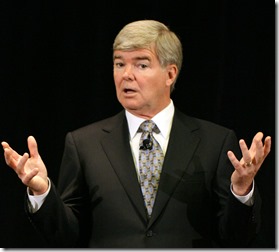
![Ed%20O'Bannon%20UCLA[1] Ed%20O'Bannon%20UCLA[1]](http://mgoblog.com/sites/mgoblog.com/files/images/f43d372bedf0_FCF4/Ed20OBannon20UCLA1.jpg)
The O'Bannon decision came down at six o'clock on a Friday, irritating all the journalists who suddenly had 1/3 less weekend… and sort of obliterating the NCAA.
The "sort of" part: the injunction the decision delivers doesn't radically upset the system. It prevents the NCAA from enforcing a couple of rules. The upshot is that schools can at least offer:
- full cost of attendance scholarships, and
- 5k per year from NIL rights placed in a trust that players get after their eligibility expire.
That'll add up to something in the 8k range annually for football and basketball players. It's the "at least" that's interesting. Instead of an arbitrary cap on compensation we now have an arbitrary floor. In a world where Indiana State gets to tell Michigan what to do you could be certain that compensation would be set to the minimum. But with the new autonomy structure, you might see the Big 5 go bigger.
If they do that's something that will be driven by the lower end, and primarily by basketball. Rutgers and Northwestern need all the help they can get; Michigan State is more concerned about recruiting against teams that are their equal in terms of compensation they can offer athletes.
The NCAA's autonomy structure is set up such that a UConn could choose to adopt whatever extra expenses the Power 5 did, so they would not be doomed as long as they could afford to keep up.
But even if it's not the floor, it's still not that different. Same structure, with a not-particularly-significant amount of the revenue directed to the athletes.
The "obliterating" part: Judge Wilken rejected every argument the NCAA made.
In her 99-page opinion, Wilken decreed that the NCAA's longstanding ban on compensating athletes for use of their name, image and likeness violates antitrust law. That alone was a victory for the plaintiffs, five years in the making. But more than that, Wilken repeatedly and unambiguously struck down virtually every argument the NCAA made in court in defense of the traditional collegiate model.
Well, except one. Bizarrely, it was the worst one:
Wilken sided with the NCAA on just one major issue. She empathized with the organization's mission to prevent commercial exploitation of athletes and thus denied an attempt to allow product endorsements.
The idea that getting paid for something is being exploited is the deepest weirdness the NCAA's structure has imposed on the world, and for that to come through this case unscathed is so so weird.
Other than that, though, the NCAA went 0-fer, and if they got off light it was only because the plaintiffs weren't asking for the world:
Wilken was never going to drop a nuclear bomb that completely professionalized college athletes, because that was never the scope of the case. The plaintiffs had focused specifically on athletes' rights to a share of licensing revenue derived from their appearances in television broadcast and video games.
There are cases that are are still upcoming, and now they have a court case that says they're in the right. Rutgers law professor Michael Carrier:
“There is lots of litigation going on and this is something plaintiffs can use in every case now. You have a comprehensive opinion that thoroughly looks at the justifications and thoroughly strikes them down. The NCAA may disagree, but the default position now is the NCAA does not have its amateurism defense position to stand behind.”
Bomb's gone off, and now we're waiting for the shock wave.
So now what?
Appeals that probably won't change much other than some numbers. ESPN's Lester Munson sums up the NCAA's position here:
As accurate and as obvious as her ruling seems to be, the NCAA cannot accept it. It must appeal the ruling to preserve even a slim chance in the other antitrust cases the NCAA faces, and it must persist in its claim that its rules are reasonable and legal.
A hopeless rearguard action.